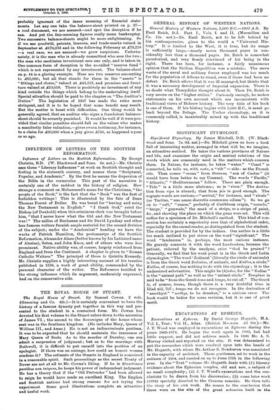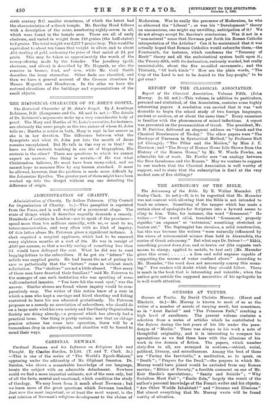EXCAVATIONS AT EPHESUS.
Excavations at Ephesus. By David George Hogarth, M.A. Vol. I., Text; Vol. II., Atlas. (British Museum. .22 10s.)—Mr. J. T. Wood was employed iu excavations at Ephesus during the years 1869-1874. He began the work again in 1883, but had little support, and did not achieve much. In 1896 Mr. A. S. Murray visited and reported on the site. It was determined to put the researches which were resolved upon into the hands of Mr. Hogarth, with whom Mr. Arthur E. Henderson was associated in the capacity of architect. These gentlemen net to work in the autumn of 1904, and carried on up to June 17th in the following year. In the " Text " volume Mr. Hogarth deals with (1) literary evidence about the Ephesian temples, old and new, a subject of no small complexity; (2) J. T. Wood's excavations and the con- clusions to be drawn from his discoveries ; (8) some later work (1894) specially directed to the Croesus remains. He then tells the story of his own work. He comes to the conclusion that there were on the site of the great artemisia built in the
sixth century B.C. smaller structures, of which the latest had the characteristics of a Greek temple. Mr. Barclay Head follows with a description of the coins, numbering eighty-seven in all, which were found in the temple area. These are all of early electrum, and varied in weight from 110 grains (the half-stater) to 2 grains. The total weight was 2,2571 grains troy. This would be equivalent to about ten times that weight in silver, and to about £14 sterling of gold, reckoning the price of that metal at 2d. per grain. This may be taken as approximately the worth of the money-offering made by the founder. The jewellery (gold, electrum, and silver) is described by Mr. Hogarth, as also the remains in bronze, lead, and. iron, while Mr. Cecil Smith describes the ivory statuettes. Other finds are classified, and then we have a general account of the Croesus structure by Messrs. Hogarth and Henderson. In the atlas we have the restored elevations of the buildings and representations of the small objects.

























































 Previous page
Previous page